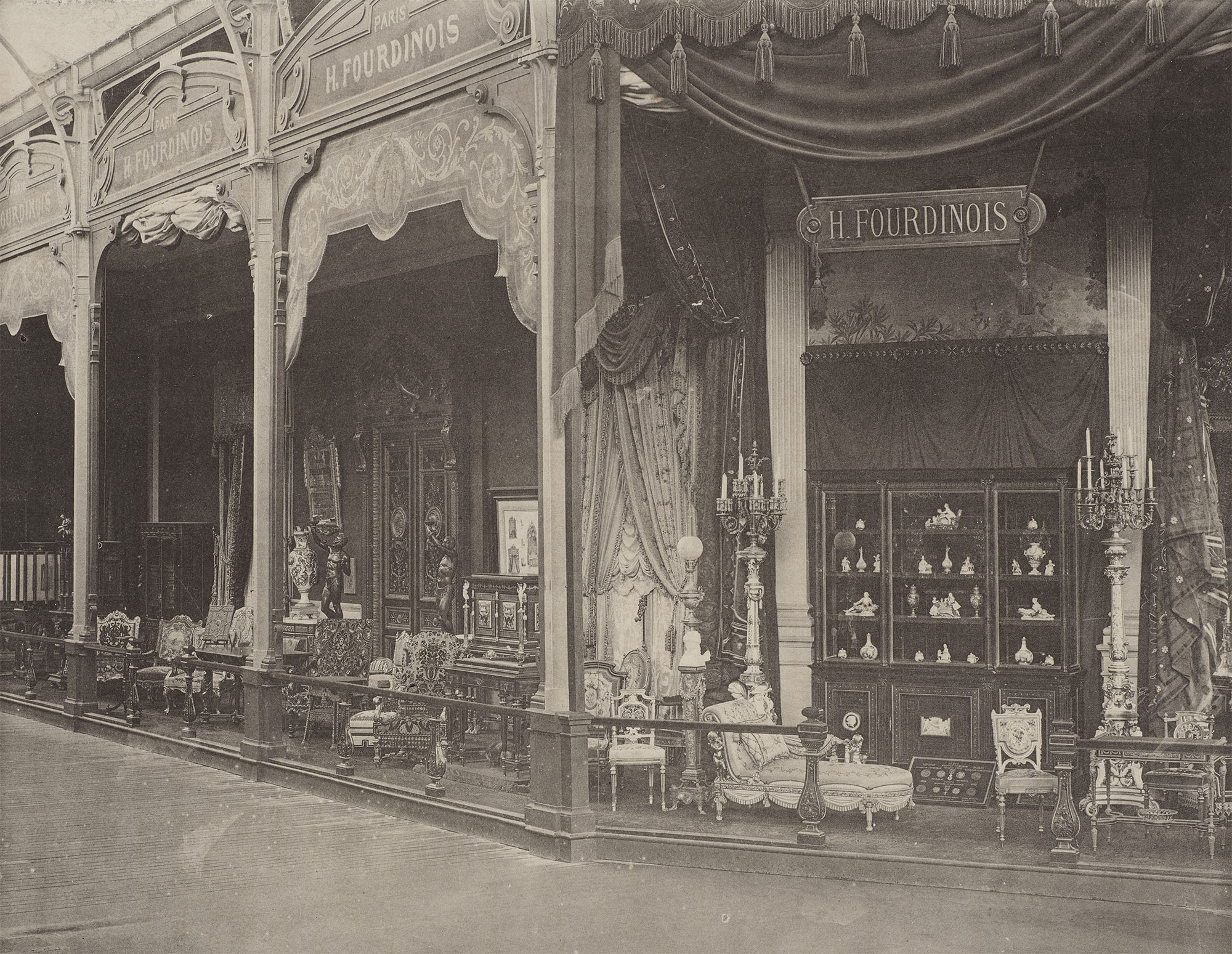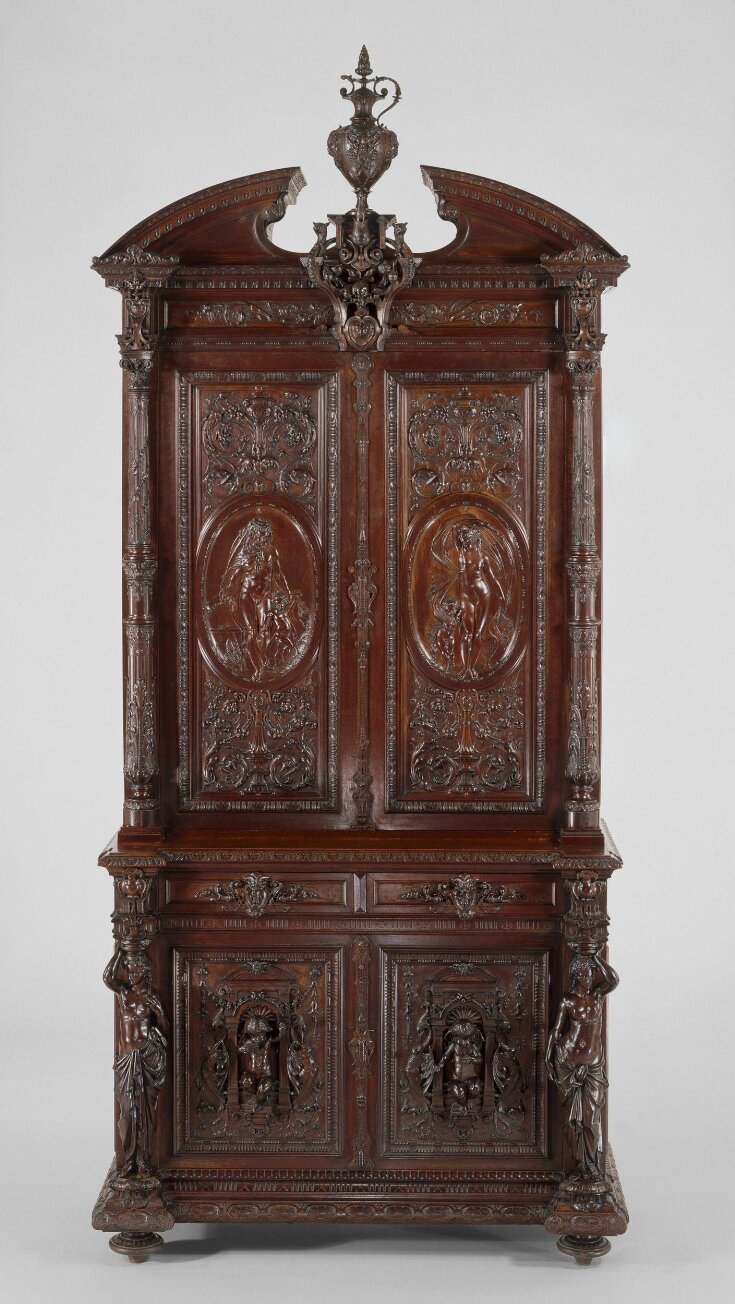Creation
Alexandre-Georges Fourdinois (1799-1871), the Maison’s founder, would come from a Parisian family of wooden sculptors. That is probably why he integrates the woodmaking workshop of François-Honoré-Georges Jacob-Desmalter, which tradition goes back to the previous generation, of George Jacob : active under Louis XV’s reign, he was first and foremost the woodmaker attached to queen Marie-Antoinette and to the Empire at the beginning of the 19th century. With this teaching, Fourdinois senior founded his society in 1828.
The association Fourdinois-Fossey
Alexandre-Georges then associated himself with another important artist, Jules Fossey, formed in England next to John Gregory Crace – the lattest being at the head of a dynasty about as influent and innovative as the Jacob’s in France.
First exhibition
The first time the Fourdinois-Fossey association entered a large scale event was during the 1844 Exhibition of Products of French Industry, where their neo-Renaissance dresser won a silver medal. After this success, important sponsors were to solicit them, in particular king Louis-Philippe who ordered them furnitures in the Louis XIII-style, or the Duke and Duchess of Nemours for their apartments in the Tuileries Palace.
End of the collaboration and apprenticeship of Henri-Auguste
This profitable collaboration between Fourdinois and Fossey ended however in 1848, most likely because of internal dissensions.
At the same time, Alexandre-Georges was preparing the artistic education of his son Henri-Auguste (1830-1907) : the lattest was 16 years-old when he integrated the workshop of Félix Duban (1797-1870), who was then occupied by the restauration of the Royal Château de Blois. As Georges Barral used to write in the 1880’s, « Mr. Fourdinois senior, by having his son educated as an architect, felt the intimate alliance between the two arts, […] to resolve this great and complicated problem : harmony’s unity in the infinity of details ». Henri-Auguste pursued his apprenticeship in England, forced like many others artists into exile after the French Revolution of 1848. He met there the goldsmith Morel, and contributed to the success of his new company, Morel & Co, during the Great Exhibition of 1851. When he got back to Paris, Fourdinois junior started to work for a bronzemaker, Victor Paillard, before completing his learning days by becoming a designer in one of the first tapestry factories.
The first International Exhibitions
Alexandre Fourdinois participated to the Great Exhibition of London in 1851 and won the medal. He participated then in 1855 to the Parisian World’s Fair and obtained a medal of honor together with the art caster Barbedienne.
Cabinet presented during the International Exhibition of 1855, conserved today in the Victoria & Albert Museum
The arrival of Henri Fourdinois in the company
It is around 1860 that Henri-Auguste became important for his father’s company, even if sources are scarce to support such a theory, and that it is only in 1867 that Fourdinois senior definitely withdrawn himself from the Maison’s leadership. Nevertheless, he contributed to the diversification of the activities : cabinetmaking, bronzemaking and also tapestry.
Patent
On March 25th 1864, Henri Fourdinois invented a kind of polychrome sculpture in natural wood, etc. It would be by working in his father’s workshop, restoring antique furniture and creating copies, that Henri Fourdinois came up with the idea for a new inlaid technique. Traditional marquetries had been carried out using thin wood veneer, which was not an integral part of the support, and that could quickly be spoiledor detach themselves. He invented a way joining the advantages of sculpture and mosaic, to avoid the shortcomings of veneer by making the encrusted elements part of the background support, and so, more firmly attached.
It involved inlaying the wood in its full width, enabling the sculpture to be cut into : the sculptor could then work on the mass and obtain an either concave or hollow surface. The cut was somehow similar to the one in Boulle marquetry, Fourdinois cut out two pieces of different colors according to the same patterns, across the full width, as with a die cutter.
Our cabinet shows a luxurious variant of the original technical because the inlay with silver on the frieze and the pilaster gives it all its rarity and preciousness.
The International Exhibitions
The Fourdinois company stood out during every World’s Fair it entered.
1867 was a synonym for consecration for Henri-Auguste, who displayed for the second Parisian World’s Fair a cabinet which was immediately included in the collections of the South Kensington Museum of London – the first museum for decorative arts and also the most important at this time. Fourdinois’s booth, really noteworthy, was also honoured by the king of Spain, who bought the bed which was on display.
The Maison Fourdinois kept then on distinguishing itself during the World’s Fairs of Vienna in 1873, or Paris in 1878.

Photography of the Fourdinois display in the International Exhibition of 1878
The end of the production
Henri-Auguste Fourdinois have received every honour an artistic woodmaker could dream of : next to the gold medals, the Grand Prix, the honorary diplomas, he was also awarded with the Croix de chevalier de la Légion d’honneur in 1870. If his company, on the edge of collapsing, had to close in 1887, it remains emblematic in its production of a taste and of an art of living characteristical of the Second Empire, still dazzling nowadays with its splendour and luxury.
We would here use Georges Barral’s words again, to significate in a more concrete way who Henri-Auguste Fourdinois was to his contemporaries : « half a century from here, the future furniture historians […] will quote Mr. Fourdinois’s name successively to the great names of his art […] we can not imagine that he will not appear among the illustrious ».







